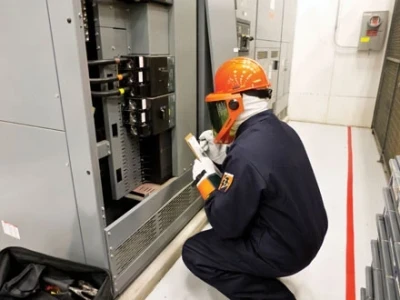Arc Flash Mitigation in LV Systems

A common misconception within the electrical industry is that low-voltage systems (typically operating at 600V or lower) pose a lesser arc flash risk than their higher voltage counterparts. While the potential incident energy may be lower in some cases, underestimating the hazards present in low-voltage systems can have devastating consequences. This article aims to debunk this misconception and outline strategies for effectively managing arc flash hazards within low-voltage environments.
Visit Our Arc Flash Study Course
Why Low-Voltage Does Not Equal No Risk
- Available Fault Current: Modern electrical systems often have high available fault currents, even at lower voltage levels. This means that in the event of a short circuit, significant energy can be released within a short duration.
- Proximity to Workers: In low-voltage applications, workers frequently interact with energized equipment within closer proximity. This smaller working distance reduces the time for reaction and can make the consequences of an arc flash more severe.
- Aging Equipment: Older low-voltage systems may contain underrated protective devices or have deteriorated components, increasing the likelihood of malfunctions that could initiate an arc flash.
Mitigation Strategies for Low-Voltage Systems
- Hazard Analysis: Thorough arc flash hazard analysis remains critical. Even in low-voltage scenarios, it's essential to calculate incident energy levels, establish arc flash boundaries, and specify proper PPE.
- Engineering Controls: Implementing arc-resistant switchgear, whenever possible, provides an extra layer of protection. Remote racking solutions reduce exposure to potential arc flash events during operation.
- Protective Device Maintenance and Upgrades: Ensuring proper maintenance and coordination of fuses and circuit breakers minimizes the duration of faults. Consider replacing older equipment with current-limiting devices to reduce arc flash energy.
- Electrical Safety Practices: Energized work should be minimized whenever possible. When work on live equipment is necessary, adhere to strict lockout/tagout procedures, utilize insulated tools, and follow NFPA 70E standards.
- Worker Training: Comprehensive training in arc flash hazards, specifically as they apply to low-voltage systems, and the correct use of PPE empowers workers and fosters a safety-focused culture.
The Misconception of Low-Voltage Safety
Low-voltage systems, typically defined as systems operating at 600 volts or less, are often perceived as less dangerous. This perception is misleading because the severity of an arc flash incident is not solely dependent on the voltage level but also on the available fault current and the duration of the arc. In many cases, low-voltage equipment can have high fault currents, leading to significant arc flash energy levels.
Arc Flash Energy in Low-Voltage Systems
The energy released during an arc flash event is a function of the fault current and the time it takes for the protective devices to clear the fault. Low-voltage systems can have protective devices with longer clearing times, contributing to higher incident energy levels and, consequently, more severe hazards.
Strategies for Arc Flash Mitigation in LV Environments
Effective arc flash mitigation in low-voltage systems involves a comprehensive approach that includes risk assessment, engineering controls, and personal protective equipment (PPE).
Risk Assessment and Analysis
Conducting a detailed arc flash hazard analysis is the first step in understanding the risks in low-voltage systems. This analysis should calculate the incident energy levels, define arc flash boundaries, and determine the appropriate PPE categories for workers.
Engineering Controls
Implementing engineering controls is a critical strategy for mitigating arc flash risks. These controls can include:
- Improving Protective Device Coordination: Enhancing the coordination of protective devices to ensure they operate more quickly and reduce the total incident energy during a fault.
- Equipment Upgrades and Maintenance: Upgrading electrical equipment to include arc flash mitigation features, such as arc-resistant switchgear, and maintaining equipment to prevent faults due to wear and tear or contamination.
Safety Practices and PPE
Despite the best engineering controls, the risk of arc flash cannot be completely eliminated. Therefore, establishing safe work practices and using the correct PPE is essential. Workers should be trained to understand the risks and the necessary precautions when working with or near low-voltage systems.
Overcoming Complacency and Enhancing Safety
The belief that low-voltage systems are safe can lead to complacency, which is dangerous in the context of arc flash hazards.
Continuous Education and Training
Educating and training electrical workers about the risks associated with low-voltage systems and the proper mitigation strategies is vital for enhancing safety. This training should emphasize that serious arc flash incidents can occur even in low-voltage systems and that appropriate safety measures are necessary.
Regular System Assessments
Electrical systems should be regularly assessed and monitored for potential risks, with adjustments made as necessary to the arc flash hazard analysis and mitigation strategies. This ongoing process ensures that changes in the electrical system or operational practices are reflected in the safety procedures.
Conclusion
Mitigating arc flash hazards in low-voltage systems requires a thorough understanding of the risks, comprehensive safety strategies, and a proactive approach to electrical safety. By acknowledging that low-voltage does not mean low-risk, organizations can implement effective measures to protect their workers from the serious consequences of arc flash incidents, enhancing safety and reducing the likelihood of accidents in the workplace.








